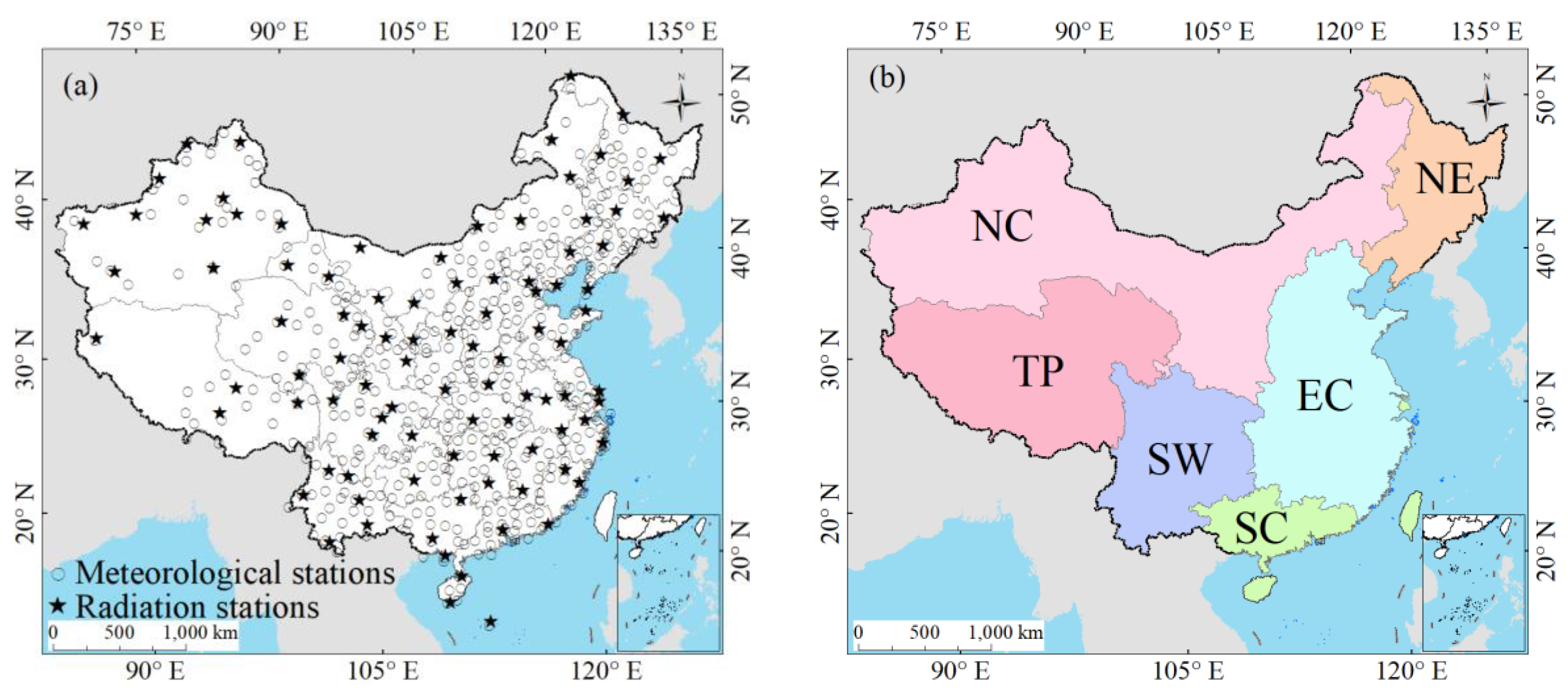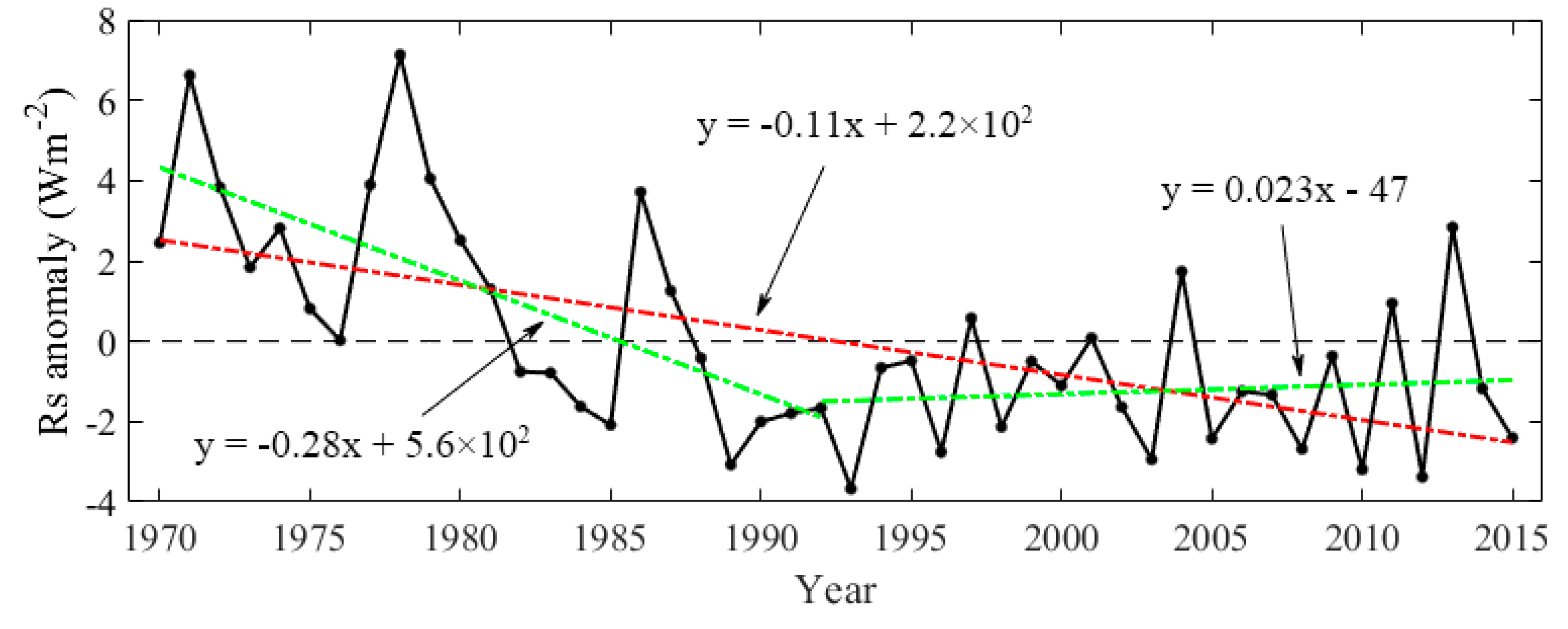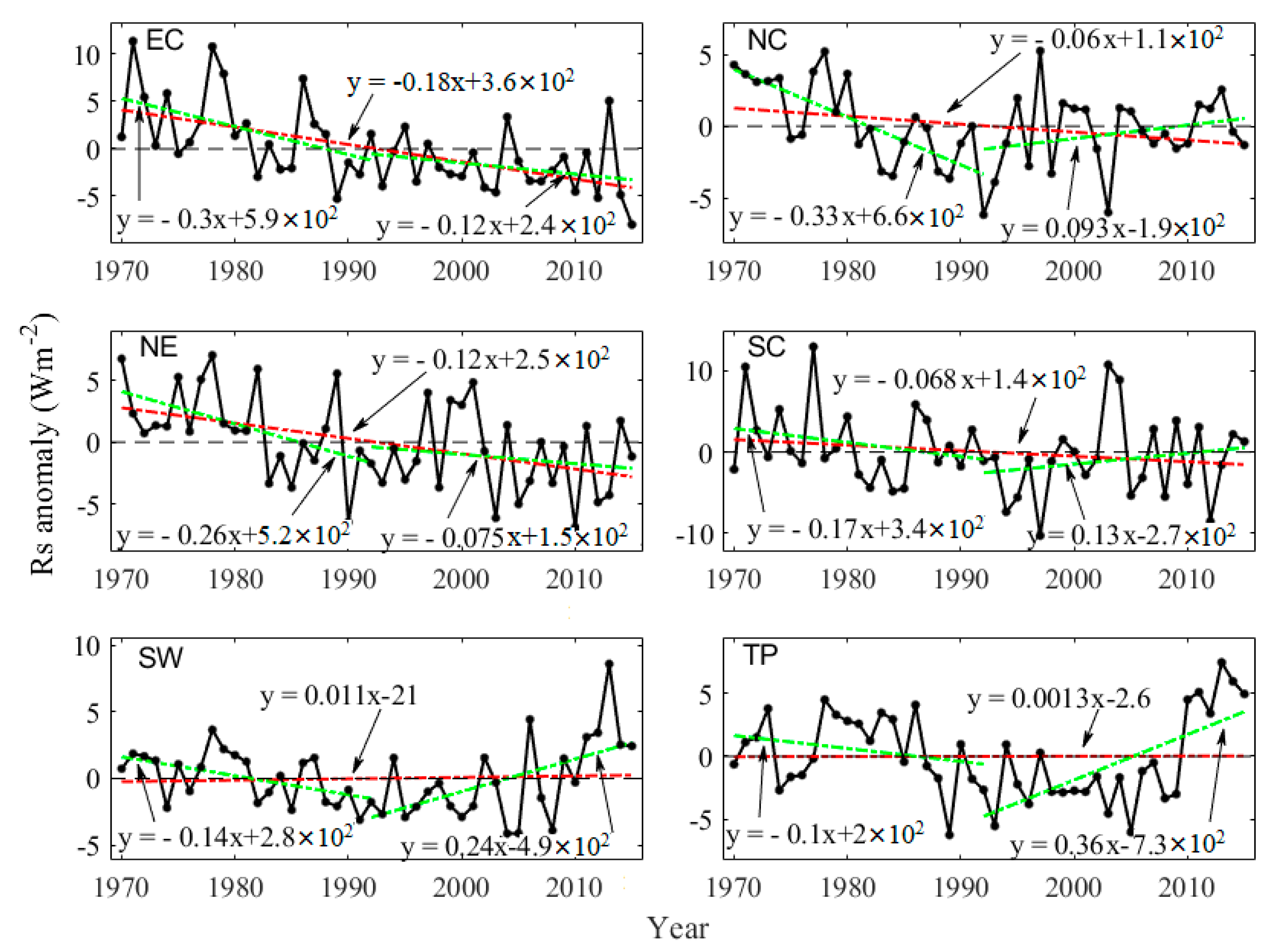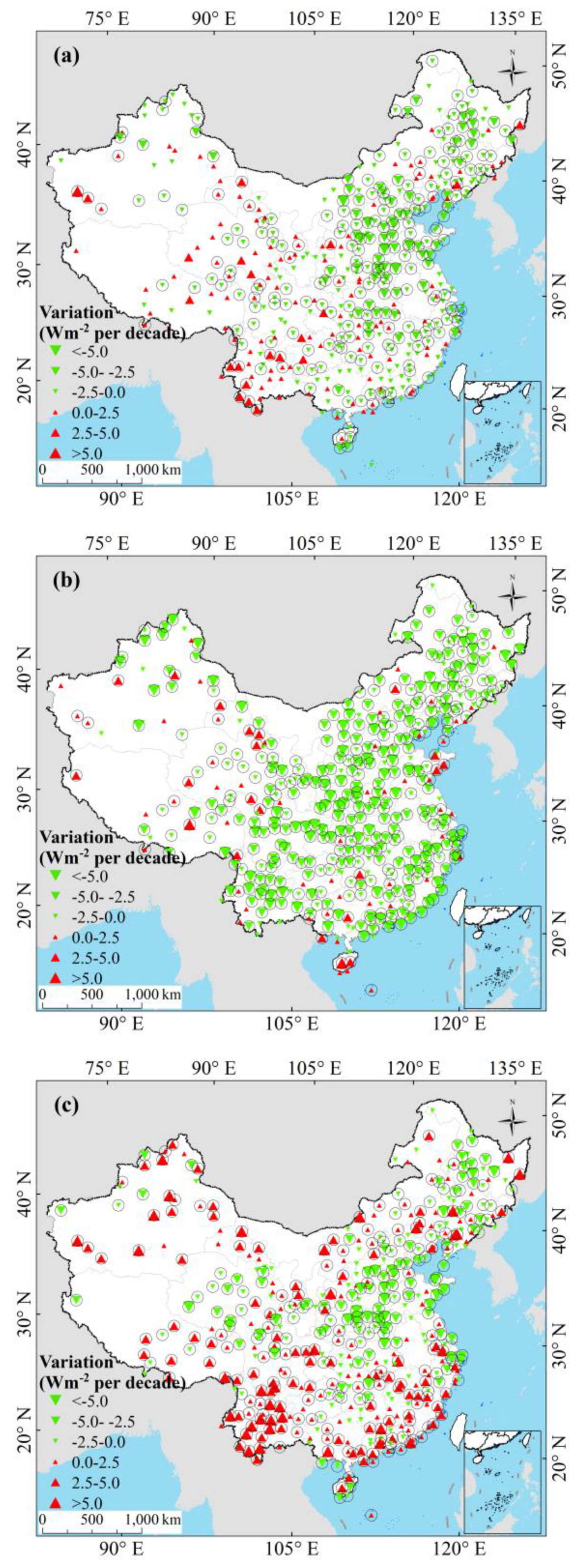A New Long-Term Downward Surface Solar Radiation Dataset over China from 1958 to 2015
Abstract
1. Introduction
2. Data
3. Methodology
3.1. Extremely Randomized Trees (ERT)
| Algorithm 1 Extremely Randomized Trees Algorithm [73] |
| Given (), (), …, (), with features space where () () training data. |
| Given the and max_depth (max depth of each tree) procedure Train ((), (), …, ()) {} for i from 1 to N do decision tree while (do depth ()) < max_depth) Random select without replacement Random select feature Use as node to construct tree end while |
| end for return end procedure procedure Test (x) |
| for i from 1 to N do |
| Select from end for |
| return y |
| end procedure |
3.2. Mann–Kendall (M-K) Test
4. Results and Analysis
4.1. Evaluation Using Ground Measurements
4.2. Spatiotemporal Analysis
4.2.1. Spatial Variations
4.2.2. Seasonal Variations
4.2.3. Decadal Variations
5. Discussion
6. Conclusions
Author Contributions
Funding
Acknowledgments
Conflicts of Interest
References
- Gupta, S.K.; Ritchey, N.A.; Wilber, A.C.; Whitlock, C.H.; Gibson, G.G.; Stackhouse, P.W. A climatology of surface radiation budget derived from satellite data. J. Clim. 1999, 12, 2691–2710. [Google Scholar] [CrossRef]
- Liang, S.; Wang, K.; Zhang, X.; Wild, M. Review on Estimation of Land Surface Radiation and Energy Budgets from Ground Measurement, Remote Sensing and Model Simulations. IEEE J. Sel. Top. Appl. Earth Obs. Remote Sens. 2010, 3, 225–240. [Google Scholar] [CrossRef]
- Hinkelman, L.M.; Jr. Stackhouse, P.W.; Wielicki, B.A.; Zhang, T.; Wilson, S.R. Surface insolation trends from satellite and ground measurements: Comparisons and challenges. J. Geophys. Res. Atmos. 2009, 114. [Google Scholar] [CrossRef]
- Mueller, R.W.; Matsoukas, C.; Gratzki, A.; Behr, H.D.; Hollmann, R. The CM-SAF operational scheme for the satellite based retrieval of solar surface irradiance-A LUT based eigenvector hybrid approach. Remote Sens. Environ. 2009, 113, 1012–1024. [Google Scholar] [CrossRef]
- Wild, M.; Folini, D.; Schaer, C.; Loeb, N.; Dutton, E.G.; Koenig-Langlo, G. The global energy balance from a surface perspective. Clim. Dyn. 2013, 40, 3107–3134. [Google Scholar] [CrossRef]
- Feng, F.; Wang, K. Determining Factors of Monthly to Decadal Variability in Surface Solar Radiation in China: Evidences from Current Reanalyses. J. Geophys. Res. Atmos. 2019, 124, 9161–9182. [Google Scholar] [CrossRef]
- Benghanem, M.; Mellit, A. Radial Basis Function Network-based prediction of global solar radiation data: Application for sizing of a stand-alone photovoltaic system at Al-Madinah, Saudi Arabia. Energy 2010, 35, 3751–3762. [Google Scholar] [CrossRef]
- Cline, D.W.; Bales, R.C.; Dozier, J. Estimating the spatial distribution of snow in mountain basins using remote sensing and energy balance modeling. Water Resour. Res. 1998, 34, 1275–1285. [Google Scholar] [CrossRef]
- Cooter, E.J.; Dhakhwa, G.B. A solar radiation model for use in biological applications in the South and Southeastern USA. Agric. For. Meteorol. 1996, 78, 31–51. [Google Scholar] [CrossRef]
- Hoogenboom, G. Contribution of agrometeorology to the simulation of crop production and its applications. Agric. For. Meteorol. 2000, 103, 137–157. [Google Scholar] [CrossRef]
- Pohlert, T. Use of empirical global radiation models for maize growth simulation. Agric. For. Meteorol. 2004, 126, 47–58. [Google Scholar] [CrossRef]
- Wild, M.; Ohmura, A.; Schar, C.; Muller, G.; Folini, D.; Schwarz, M.; Hakuba, M.Z.; Sanchez-Lorenzo, A. The global energy balance archive (GEBA) version 2017: A database for worldwide measured surface energy fluxes. Earth Syst. Sci. Data 2017, 9, 601–613. [Google Scholar] [CrossRef]
- Stanhill, G. The Distribution of Global Solar-Radiation over the Land Surfaces of the Earth. Solar Energy 1983, 31, 95–104. [Google Scholar] [CrossRef]
- Gilgen, H.; Roesch, A.; Wild, M.; Ohmura, A. Decadal changes in shortwave irradiance at the surface in the period from 1960 to 2000 estimated from Global Energy Balance Archive Data. J. Geophys. Res. Atmos. 2009, 114. [Google Scholar] [CrossRef]
- Pinker, R.T.; Zhang, B.; Dutton, E.G. Do satellites detect trends in surface solar radiation? Science 2005, 308, 850–854. [Google Scholar] [CrossRef] [PubMed]
- Wild, M. Global dimming and brightening: A review. J. Geophys. Res. Atmos. 2009, 114. [Google Scholar] [CrossRef]
- Liepert, B.G. Observed reductions of surface solar radiation at sites in the United States and worldwide from 1961 to 1990. Geophys. Res. Lett. 2002, 29. [Google Scholar] [CrossRef]
- Wild, M.; Gilgen, H.; Roesch, A.; Ohmura, A.; Long, C.N.; Dutton, E.G.; Forgan, B.; Kallis, A.; Russak, V.; Tsvetkov, A. From dimming to brightening: Decadal changes in solar radiation at Earth’s surface. Science 2005, 308, 847–850. [Google Scholar] [CrossRef]
- Norris, J.R.; Wild, M. Trends in aerosol radiative effects over Europe inferred from observed cloud cover, solar “dimming” and solar “brightening”. J. Geophys. Res. Atmos. 2007, 112. [Google Scholar] [CrossRef]
- Kambezidis, H.D. The solar radiation climate of Athens: Variations and tendencies in the period 1992-2017, the brightening era. Sol. Energy 2018, 173, 328–347. [Google Scholar] [CrossRef]
- Long, C.N.; Dutton, E.G.; Augustine, J.A.; Wiscombe, W.; Wild, M.; McFarlane, S.A.; Flynn, C.J. Significant decadal brightening of downwelling shortwave in the continental United States. J. Geophys. Res. Atmos. 2009, 114. [Google Scholar] [CrossRef]
- Augustine, J.A.; Dutton, E.G. Variability of the surface radiation budget over the United States from 1996 through 2011 from high-quality measurements. J. Geophys. Res. Atmos. 2013, 118, 43–53. [Google Scholar] [CrossRef]
- Ohmura, A. Observed decadal variations in surface solar radiation and their causes. J. Geophys. Res. Atmos. 2009, 114. [Google Scholar] [CrossRef]
- Norris, J.R.; Wild, M. Trends in aerosol radiative effects over China and Japan inferred from observed cloud cover, solar “dimming” and solar “brightening”. J. Geophys. Res. 2009, 114. [Google Scholar] [CrossRef]
- Yang, S.; Wang, X.L.L.; Wild, M. Homogenization and trend analysis of the 1958–2016 in situ surface solar radiation records in China. J. Clim. 2018, 31, 4529–4541. [Google Scholar] [CrossRef]
- Wang, Y.W.; Trentmann, J.; Pfeifroth, U.; Yuan, W.P.; Wild, M. Improvement of air pollution in china inferred from changes between satellite-based and measured surface solar radiation. Remote Sens. 2019, 11, 2910. [Google Scholar] [CrossRef]
- Yang, S.; Wang, X.L.L.; Wild, M. Causes of dimming and brightening in china inferred from homogenized daily clear-sky and all-sky in situ surface solar radiation records (1958–2016). J. Clim. 2019, 32, 5901–5913. [Google Scholar] [CrossRef]
- Schwarz, M.; Folini, D.; Yang, S.; Allan, R.P.; Wild, M. Changes in atmospheric shortwave absorption as important driver of dimming and brightening. Nat. Geosci. 2020, 13, 110–115. [Google Scholar] [CrossRef]
- Che, H.Z.; Shi, G.Y.; Zhang, X.Y.; Arimoto, R.; Zhao, J.Q.; Xu, L.; Wang, B.; Chen, Z.H. Analysis of 40 years of solar radiation data from China, 1961-2000. Geophys. Res. Lett. 2005, 32. [Google Scholar] [CrossRef]
- Qian, Y.; Kaiser, D.P.; Leung, L.R.; Xu, M. More frequent cloud-free sky and less surface solar radiation in China from 1955 to 2000. Geophys. Res. Lett. 2006, 33. [Google Scholar] [CrossRef]
- Xia, X. A closer looking at dimming and brightening in China during 1961–2005. Ann. Geophys. 2010, 28, 1121–1132. [Google Scholar] [CrossRef]
- Wang, K.; Ye, H.; Chen, F.; Xiong, Y.; Wang, C. Urbanization effect on the diurnal temperature range: Different roles under solar dimming and brightening*. J. Clim. 2012, 25, 1022–1027. [Google Scholar] [CrossRef]
- Wang, K.C. Measurement biases explain discrepancies between the observed and simulated decadal variability of surface incident solar radiation. Sci. Rep. UK 2014, 4. [Google Scholar] [CrossRef] [PubMed]
- Manara, V.; Beltrano, M.C.; Brunetti, M.; Maugeri, M.; Sanchez-Lorenzo, A.; Simolo, C.; Sorrenti, S. Sunshine duration variability and trends in Italy from homogenized instrumental time series (1936–2013). J. Geophys. Res. Atmos. 2015, 120, 3622–3641. [Google Scholar] [CrossRef]
- Wang, K.; Dickinson, R.E.; Ma, Q.; Augustine, J.A.; Wild, M. Measurement Methods Affect the Observed Global Dimming and Brightening. J. Clim. 2013, 26, 4112–4120. [Google Scholar] [CrossRef]
- Wang, K.; Dickinson, R.E.; Wild, M.; Liang, S. Atmospheric impacts on climatic variability of surface incident solar radiation. Atmos. Chem. Phys. 2012, 12, 9581–9592. [Google Scholar] [CrossRef]
- Zhang, X.; Liang, S.; Wild, M.; Jiang, B. Analysis of surface incident shortwave radiation from four satellite products. Remote Sens. Environ. 2015, 165, 186–202. [Google Scholar] [CrossRef]
- Kumar, R.; Aggarwal, R.K.; Sharma, J.D. Comparison of regression and artificial neural network models for estimation of global solar radiations. Renew. Sustain. Energy Rev. 2015, 52, 1294–1299. [Google Scholar] [CrossRef]
- Meza, F.; Varas, E. Estimation of mean monthly solar global radiation as a function of temperature. Agric. Forest Meteorol. 2000, 100, 231–241. [Google Scholar] [CrossRef]
- Tang, W.; Yang, K.; Qin, J.; Min, M. Development of a 50-year daily surface solar radiation dataset over China. Sci. China Earth Sci. 2013, 56, 1555–1565. [Google Scholar] [CrossRef]
- Tang, W.J.; Qin, J.; Yang, K.; Niu, X.L.; Zhang, X.T.; Yu, Y.; Zhu, X.D. Reconstruction of daily photosynthetically active radiation and its trends over China. J. Geophys. Res. Atmos. 2013, 118, 13292–13302. [Google Scholar] [CrossRef]
- Yang, K.; Koike, T.; Ye, B.S. Improving estimation of hourly, daily, and monthly solar radiation by importing global data sets. Agric. For. Meteorol. 2006, 137, 43–55. [Google Scholar] [CrossRef]
- Tang, W.; Yang, K.; He, J.; Qin, J. Quality control and estimation of global solar radiation in China. Sol. Energy 2010, 84, 466–475. [Google Scholar] [CrossRef]
- Ghayekhloo, M.; Ghofrani, M.; Menhaj, M.B.; Azimi, R. A novel clustering approach for short-term solar radiation forecasting. Sol. Energy 2015, 122, 1371–1383. [Google Scholar] [CrossRef]
- Dos Santos, C.M.; De Souza, J.L.; Ferreira Junior, R.A.; Tiba, C.; de Melo, R.O.; Lyra, G.B.; Teodoro, I.; Lyra, G.B.; Lemes, M.A.M. On modeling global solar irradiation using air temperature for Alagoas State, Northeastern Brazil. Energy 2014, 71, 388–398. [Google Scholar] [CrossRef]
- Katiyar, A.K.; Pandey, C.K. Simple correlation for estimating the global solar radiation on horizontal surfaces in India. Energy 2010, 35, 5043–5048. [Google Scholar] [CrossRef]
- Qin, J.; Tang, W.J.; Yang, K.; Lu, N.; Niu, X.L.; Liang, S.L. An efficient physically based parameterization to derive surface solar irradiance based on satellite atmospheric products. J. Geophys. Res. Atmos. 2015, 120, 4975–4988. [Google Scholar] [CrossRef]
- Piri, J.; Shamshirband, S.; Petkovic, D.; Tong, C.W.; Rehman, M.H.U. Prediction of the solar radiation on the Earth using support vector regression technique. Infrared Phys. Technol. 2015, 68, 179–185. [Google Scholar] [CrossRef]
- Yao, W.; Zhang, C.; Hao, H.; Wang, X.; Li, X. A support vector machine approach to estimate global solar radiation with the influence of fog and haze. Renew. Energy 2018, 128, 155–162. [Google Scholar] [CrossRef]
- Zhou, Z.; Lin, A.; Wang, L.; Qin, W.; Zhong, Y.; He, L. Trends in downward surface shortwave radiation from multi-source data over China during 1984–2015. Int. J. Climatol. 2019, 40, 3467–3485. [Google Scholar] [CrossRef]
- Ruiz-Arias, J.A.; Gueymard, C.A.; Santos-Alamillos, F.J.; Quesada-Ruiz, S.; Pozo-Vázquez, D. Bias induced by the AOD representation time scale in long-term solar radiation calculations. Part 2: Impact on long-term solar irradiance predictions. Sol. Energy 2016, 135, 625–632. [Google Scholar] [CrossRef]
- Ruiz-Arias, J.A. Bias in modeled solar radiation by non-resolved intra-daily AOD variability. Sol. Energy 2020, 205, 221–229. [Google Scholar] [CrossRef]
- Fan, J.L.; Wang, X.K.; Wu, L.F.; Zhou, H.M.; Zhang, F.C.; Yu, X.; Lu, X.H.; Xiang, Y.Z. Comparison of Support Vector Machine and Extreme Gradient Boosting for predicting daily global solar radiation using temperature and precipitation in humid subtropical climates: A case study in China. Energy Convers. Manag. 2018, 164, 102–111. [Google Scholar] [CrossRef]
- Wang, L.C.; Kisi, O.; Zounemat-Kermani, M.; Zhu, Z.M.; Gong, W.; Niu, Z.G.; Liu, H.F.; Liu, Z.J. Prediction of solar radiation in China using different adaptive neuro-fuzzy methods and M5 model tree. Int. J. Climatol. 2017, 37, 1141–1155. [Google Scholar] [CrossRef]
- Wei, Y.; Zhang, X.; Hou, N.; Zhang, W.; Jia, K.; Yao, Y. Estimation of surface downward shortwave radiation over China from AVHRR data based on four machine learning methods. Sol. Energy 2019, 177, 32–46. [Google Scholar] [CrossRef]
- Hou, N.; Zhang, X.T.; Zhang, W.Y.; Wei, Y.; Jia, K.; Yao, Y.J.; Jiang, B.; Cheng, J. Estimation of surface downward shortwave radiation over china from himawari-8 ahi data based on random forest. Remote Sens. 2020, 12, 181. [Google Scholar] [CrossRef]
- Yang, L.; Zhang, X.T.; Liang, S.L.; Yao, Y.J.; Jia, K.; Jia, A.L. Estimating surface downward shortwave radiation over china based on the gradient boosting decision tree method. Remote Sens. 2018, 10, 185. [Google Scholar] [CrossRef]
- Wang, T.; Yan, G.; Chen, L. Consistent retrieval methods to estimate land surface shortwave and longwave radiative flux components under clear-sky conditions. Remote Sens. Environ. 2012, 124, 61–71. [Google Scholar] [CrossRef]
- Rodríguez-Benítez, F.J.; Arbizu-Barrena, C.; Huertas-Tato, J.; Aler-Mur, R.; Galván-León, I.; Pozo-Vázquez, D. A short-term solar radiation forecasting system for the Iberian Peninsula. Part 1: Models description and performance assessment. Sol. Energy 2020, 195, 396–412. [Google Scholar] [CrossRef]
- Cornejo-Bueno, L.; Casanova-Mateo, C.; Sanz-Justo, J.; Salcedo-Sanz, S. Machine learning regressors for solar radiation estimation from satellite data. Sol. Energy 2019, 183, 768–775. [Google Scholar] [CrossRef]
- Hao, D.; Asrar, G.R.; Zeng, Y.; Zhu, Q.; Wen, J.; Xiao, Q.; Chen, M. Estimating hourly land surface downward shortwave and photosynthetically active radiation from DSCOVR/EPIC observations. Remote Sens. Environ. 2019, 232, 111320. [Google Scholar] [CrossRef]
- Ibrahim, I.A.; Khatib, T. A novel hybrid model for hourly global solar radiation prediction using random forests technique and firefly algorithm. Energy Convers. Manag. 2017, 138, 413–425. [Google Scholar] [CrossRef]
- Wehenkel, L.; Ernst, D.; Geurts, P. Ensembles of extremely randomized trees and some generic applications. In Proceedings of the Robust Methods for Power System State Estimation and Load Forecasting, Versailles, France, 29–30 May 2006. [Google Scholar]
- Moradi, I. Quality control of global solar radiation using sunshine duration hours. Energy 2009, 34, 1–6. [Google Scholar] [CrossRef]
- Wei, J.; Li, Z.; Cribb, M.; Huang, W.; Xue, W.; Sun, L.; Guo, J.; Peng, Y.; Li, J.; Lyapustin, A.; et al. Improved 1 km resolution PM2.5 estimates across China using enhanced space–time extremely randomized trees. Atmos. Chem. Phys. 2020, 20, 3273–3289. [Google Scholar] [CrossRef]
- Lam, J.C.; Wan, K.K.W.; Yang, L. Solar radiation modelling using ANNs for different climates in China. Energy Convers. Manag. 2008, 49, 1080–1090. [Google Scholar] [CrossRef]
- Lau, C.C.S.; Lam, J.C.; Yang, L. Climate classification and passive solar design implications in China. Energy Convers Manag. 2007, 48, 2006–2015. [Google Scholar] [CrossRef]
- Wang, C.H.; Zhang, Z.F.; Tian, W.S. Factors affecting the surface radiation trends over China between 1960 and 2000. Atmos. Env. 2011, 45, 2379–2385. [Google Scholar] [CrossRef]
- Zhou, Z.G.; Wang, L.C.; Lin, A.W.; Zhang, M.; Niu, Z.G. Innovative trend analysis of solar radiation in China during 1962-2015. Renew. Energy 2018, 119, 675–689. [Google Scholar] [CrossRef]
- Geurts, P.; Wehenkel, L. Investigation and reduction of discretization variance in decision tree induction. Lect. Notes Artif. Int. 2000, 1810, 162–170. [Google Scholar]
- Wehenkel, L. Discretization of continuous attributes for supervised learning. variance evaluation and variance reduction. Proc. Seventh Int. Fuzzy Syst. Assoc. World Congr. 2012, 1, 413–418. [Google Scholar]
- Breiman, L. Random forests. Mach. Learn. 2001, 45, 5–32. [Google Scholar] [CrossRef]
- Geurts, P.; Ernst, D.; Wehenkel, L. Extremely randomized trees. Mach. Learn. 2006, 63, 3–42. [Google Scholar] [CrossRef]
- Basith, S.; Manavalan, B.; Shin, T.H.; Lee, G. iGHBP: Computational identification of growth hormone binding proteins from sequences using extremely randomised tree. Comput. Struct. Biotechnol. J. 2018, 16, 412–420. [Google Scholar] [CrossRef]
- Manavalan, B.; Govindaraj, R.G.; Shin, T.H.; Kim, M.O.; Lee, G. iBCE-EL: A new ensemble learning framework for improved linear b-cell epitope prediction. Front. Immunol. 2018, 9, 1695. [Google Scholar] [CrossRef] [PubMed]
- Manavalan, B.; Basith, S.; Shin, T.H.; Wei, L.; Lee, G. AtbPpred: A robust sequence-based prediction of anti-tubercular peptides using extremely randomized trees. Comput. Struct. Biotechnol. J. 2019, 17, 972–981. [Google Scholar] [CrossRef] [PubMed]
- Mann, H.B. Non–parametric tests against trend. Econometrica 1945, 13, 245–259. [Google Scholar] [CrossRef]
- Kendall, M.G. Rank Correlation Methods; Charles Griffin: London, UK, 1975; p. 220. [Google Scholar]
- Li, H.S.; Ma, W.B.; Lian, Y.W.; Wang, X.L.; Zhao, L. Global solar radiation estimation with sunshine duration in Tibet, China. Renew. Energy 2011, 36, 3141–3145. [Google Scholar] [CrossRef]
- Zhang, X.Z.; Zhang, Y.G.; Zhoub, Y.H. Measuring and modelling photosynthetically active radiation in Tibet Plateau during April-October. Agric. Forest Meteorol. 2000, 102, 207–212. [Google Scholar] [CrossRef]
- Feng, Y.; Li, Y.T. Estimated spatiotemporal variability of total, direct and diffuse solar radiation across China during 1958–2016. Int. J. Climatol. 2018, 38, 4395–4404. [Google Scholar] [CrossRef]
- Yang, H.B.; Yang, D.W.; Hu, Q.F.; Lv, H.F. Spatial variability of the trends in climatic variables across China during 1961–2010. Theor. Appl. Climatol. 2015, 120, 773–783. [Google Scholar] [CrossRef]
- Ren, G.; Guo, J.; Xu, M.; Chu, Z.; Zhang, L.; Zou, X.; Li, Q.; Liu, X. Climate changes of china’s mainland over the past half century. Acta Meteorol. Sin. 2005, 63, 942–956. [Google Scholar]
- Li, H.; Fu, Z.; Wen, X.; Huang, J. Characteristic Analysis of Sunshine Duration Change in China during the Last 50 Years. Clim. Environ. Res. 2013, 18, 203–209. [Google Scholar]
- Wang, H.; Pinker, R.T. Shortwave radiative fluxes from MODIS: Model development and implementation. J. Geophys. Res. Atmos. 2009, 114. [Google Scholar] [CrossRef]
- Qin, W.; Wang, L.; Lin, A.; Zhang, M.; Bilal, M. Improving the Estimation of Daily Aerosol Optical Depth and Aerosol Radiative Effect Using an Optimized Artificial Neural Network. Remote Sens. 2018, 10, 1022. [Google Scholar] [CrossRef]
- Jia, B.; Xie, Z.; Dai, A.; Shi, C.; Chen, F. Evaluation of satellite and reanalysis products of downward surface solar radiation over East Asia: Spatial and seasonal variations. J. Geophys. Res. Atmos. 2013, 118, 3431–3446. [Google Scholar] [CrossRef]
- Randles, C.A.; Kinne, S.; Myhre, G.; Schulz, M.; Stier, P.; Fischer, J.; Doppler, L.; Highwood, E.; Ryder, C.; Harris, B.; et al. Intercomparison of shortwave radiative transfer schemes in global aerosol modeling: Results from the AeroCom Radiative Transfer Experiment. Atmos. Chem. Phys. 2013, 13, 2347–2379. [Google Scholar] [CrossRef]
















| Scale. | Dataset | R | RMSE | MBE | MRE | |
|---|---|---|---|---|---|---|
| National | Train | 0.99 | 3.9 | 0.01 | 1.53% | |
| Test | 0.97 | 23.12 | 0.04 | 9.81% | ||
| Regional | Train | NE | 0.99 | 3.38 | 0.28 | 1.42% |
| EC | 0.99 | 3.39 | −0.05 | 1.74% | ||
| NC | 0.99 | 4.02 | 0.2 | 1.42% | ||
| SC | 0.99 | 3.63 | −0.51 | 1.53% | ||
| SW | 0.99 | 4.05 | −0.28 | 1.64% | ||
| TP | 0.99 | 3.86 | 0.12 | 1.23% | ||
| Test | NE | 0.97 | 21.13 | 2.67 | 9.61% | |
| EC | 0.96 | 23.35 | −0.33 | 11.30% | ||
| NC | 0.97 | 23.41 | 1.2 | 8.91% | ||
| SC | 0.96 | 21.97 | −3.49 | 9.95% | ||
| SW | 0.95 | 24.63 | −2.04 | 10.64% | ||
| TP | 0.95 | 22.52 | 1.18 | 7.60% | ||
| Seasonal | Train | Spring | 0.99 | 4.5 | −0.21 | 1.53% |
| Summer | 0.99 | 4.66 | 0.1 | 1.46% | ||
| Autumn | 0.99 | 3.36 | 0.14 | 1.52% | ||
| Winter | 0.99 | 2.75 | −0.01 | 1.66% | ||
| Test | Spring | 0.95 | 26.58 | −1.48 | 9.89% | |
| Summer | 0.94 | 28.47 | 0.91 | 9.66% | ||
| Autumn | 0.96 | 19.65 | 0.8 | 9.58% | ||
| Winter | 0.96 | 15.57 | 0.07 | 10.24% | ||
| Stational | Train | 0.99 | 2.55–7.54 | −1.42–1.22 | 0.86–3.66% | |
| Test | 0.89–0.98 | 14.95–35.06 | −9.19–9.00 | 4.95–16.95% | ||
| DOY | Train | 0.99 | 2.23–5.38 | −0.73–0.76 | 1.26–1.86% | |
| Test | 0.91–0.97 | 11.32–32.97 | −5.30–6.86 | 7.55–12.77% |
| Region | Annual (1970–2015) | Annual (1970–1992) | Annual (1992–2015) | Spring | Summer | Autumn | Winter |
|---|---|---|---|---|---|---|---|
| China | −3.79 ** | −3.43 ** | 0.12 | 0.09 | −4.60 ** | −2.63 ** | −1.76 |
| EC | −4.11 ** | -1.90 | −1.81 | 0.68 | −4.56 ** | −2.63 ** | −1.65 |
| NC | −1.69 | −3.27 ** | 0.77 | 0.32 | −1.72 | −2.25 * | −1.93 |
| NE | −3.03 ** | −2.59 ** | −0.62 | −2.58 ** | −2.42 * | −1.12 | −1.86 |
| SC | −1.16 | −1.00 | 0.87 | 0.83 | −1.31 | −0.83 | −0.66 |
| SW | 1.38 | −2.32 * | 2.46 * | −0.38 | 1.40 | 1.04 | −0.49 |
| TP | 1.26 | −1.11 | 2.51 * | −0.86 | 0.73 | 1.88 | −0.57 |
| Variable | Importance | Variable | Importance |
|---|---|---|---|
| Sunshine duration | 0.47 | Elevation | 0.04 |
| Cosine of the radian difference | 0.16 | Air temperature | 0.04 |
| Air pressure | 0.13 | Wind speed | 0.01 |
| Water vapor pressure | 0.07 | Daily precipitation | 0.01 |
| Relative humidity | 0.07 |
Publisher’s Note: MDPI stays neutral with regard to jurisdictional claims in published maps and institutional affiliations. |
© 2020 by the authors. Licensee MDPI, Basel, Switzerland. This article is an open access article distributed under the terms and conditions of the Creative Commons Attribution (CC BY) license (http://creativecommons.org/licenses/by/4.0/).
Share and Cite
Hou, N.; Zhang, X.; Zhang, W.; Xu, J.; Feng, C.; Yang, S.; Jia, K.; Yao, Y.; Cheng, J.; Jiang, B. A New Long-Term Downward Surface Solar Radiation Dataset over China from 1958 to 2015. Sensors 2020, 20, 6167. https://doi.org/10.3390/s20216167
Hou N, Zhang X, Zhang W, Xu J, Feng C, Yang S, Jia K, Yao Y, Cheng J, Jiang B. A New Long-Term Downward Surface Solar Radiation Dataset over China from 1958 to 2015. Sensors. 2020; 20(21):6167. https://doi.org/10.3390/s20216167
Chicago/Turabian StyleHou, Ning, Xiaotong Zhang, Weiyu Zhang, Jiawen Xu, Chunjie Feng, Shuyue Yang, Kun Jia, Yunjun Yao, Jie Cheng, and Bo Jiang. 2020. "A New Long-Term Downward Surface Solar Radiation Dataset over China from 1958 to 2015" Sensors 20, no. 21: 6167. https://doi.org/10.3390/s20216167
APA StyleHou, N., Zhang, X., Zhang, W., Xu, J., Feng, C., Yang, S., Jia, K., Yao, Y., Cheng, J., & Jiang, B. (2020). A New Long-Term Downward Surface Solar Radiation Dataset over China from 1958 to 2015. Sensors, 20(21), 6167. https://doi.org/10.3390/s20216167









